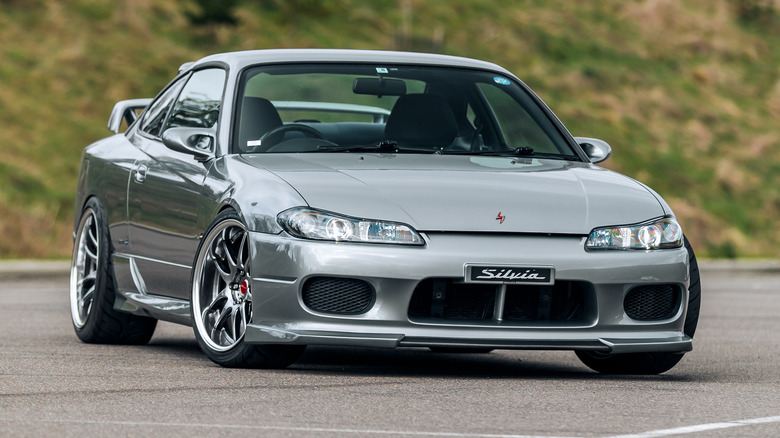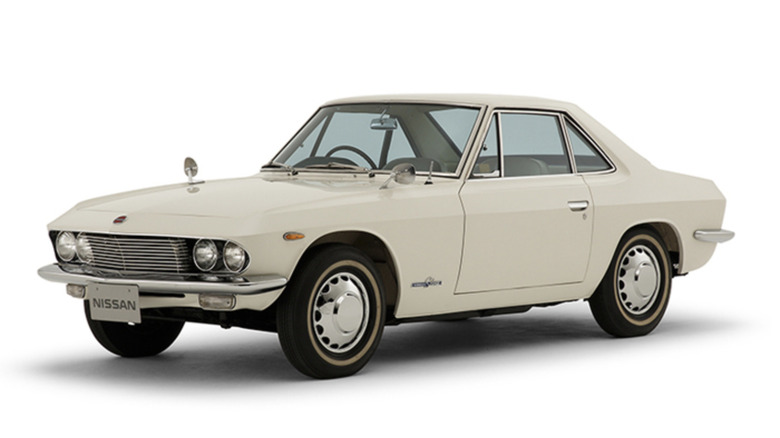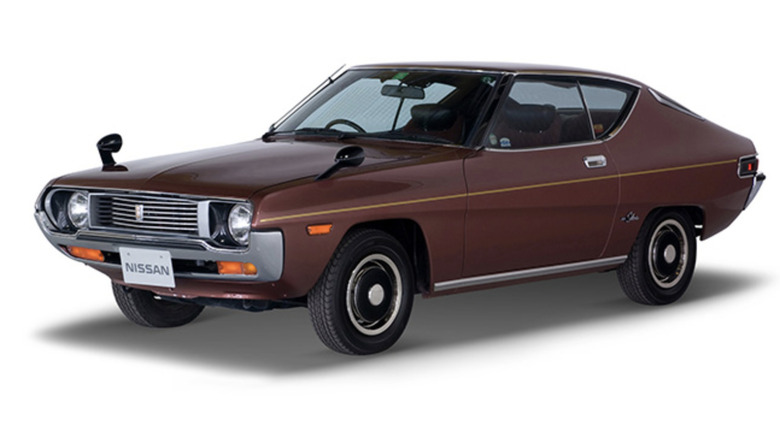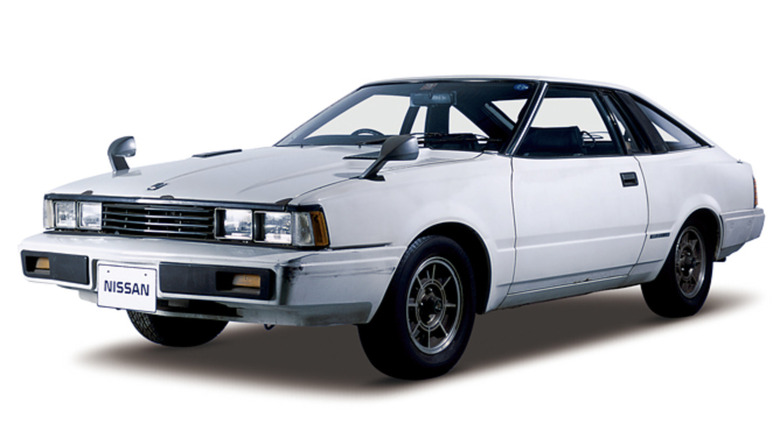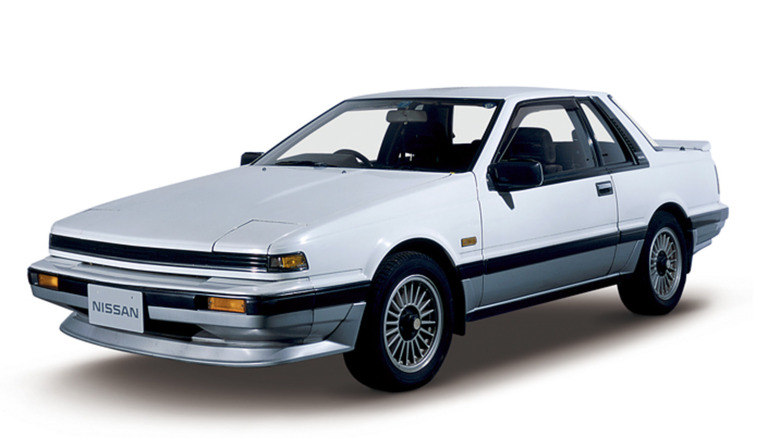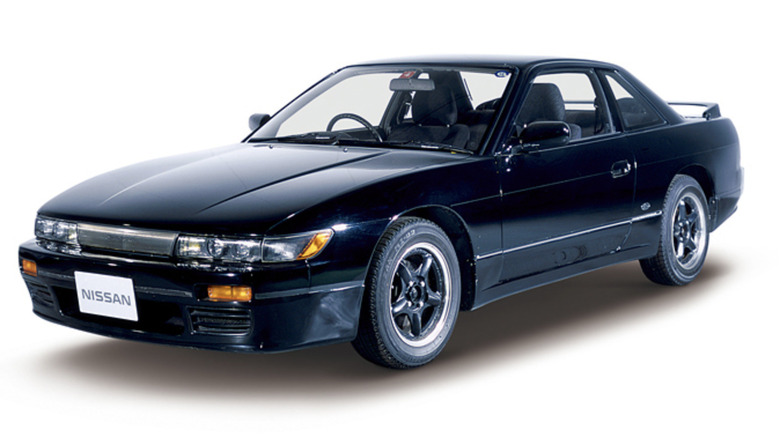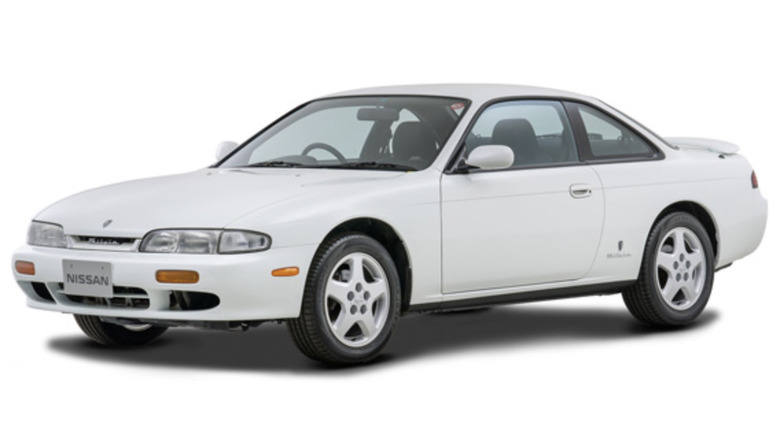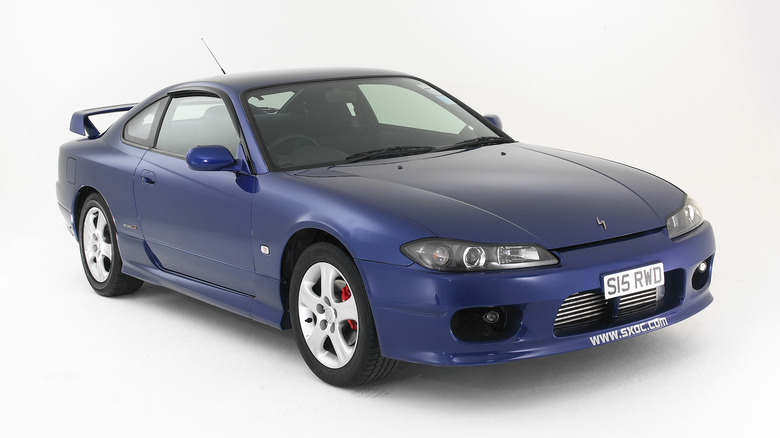Every Generation Nissan Silvia Ranked Slowest To Fastest According To Driver Tests
Nissan's Silvia should need no introduction, but it ran under the radar for some thanks to the behemoth that is the Skyline GT-R, which was produced alongside the Silvia for many years. The S13, S14, and S15 are the most well-known models — "The Fast and the Furious" fans will have a particularly soft spot for Letty's S14 – but the lineage of the S-chassis runs much deeper than that trio. Nissan launched the first Silvia in 1965, and the automaker would manufacture seven generations of the model until it ceased production in 2002.
The Silvia is especially well known among drifters. The last three generations especially are rated as some of the best drift cars ever made, but these models weren't just quick going sideways. Here, we've ranked every generation of Nissan Silvia from the slowest to the fastest. Beyond that, iconic versions of the Silvia are finally becoming available for U.S. gearheads, as the 25-year rule is up now for the S15s made in 1999.
So, if you've always longed for a Silvia in your garage, keep reading to see what generation and — more importantly — what trim is the fastest.
7. 1965 Nissan Silvia CSP311 (1st gen)
The Nissan CSP311 was the first generation of the Silvia, and it kicks off our list with a quarter-mile time of 17.9 seconds. This model was launched in 1965, and most people from the U.S. will remember it as the Datsun 1600 Coupe, as Nissan was still producing cars under the brand name Datsun in the U.S. at the time. Powering this rear-wheel drive model is a 1.6-liter engine, which produced 89 horsepower and 98 lb-ft of torque. This was enough to push the CSP311 to 60 mph in 11.6 seconds on its way to a top speed of 103 mph.
This model was born after Nissan split from German industrial designer Count Albrecht von Goertz. Nissan took the fragments of what its engineers had been working on with Goertz and created the CSP311. It's safe to say the two-door coupe's design stood the test of time and is sure to turn heads to this day, but finding one to turn your head is a considerable task, as just 554 were made.
This is a spectacularly low number for a model that was in production for three years, but it makes sense when you consider that all the bodywork was handmade by Yamaha. Hand-building the CSP311 also made it expensive, with a price tag close to double that of comparable models in Nissan's range at the time. However, perhaps the most interesting fact about this hard-to-find car is that two CSP311 were used as the first highway patrol car in Japan's Kanagawa Prefecture.
6. 1977 Nissan S10 (2nd gen)
Nissan took a seven-year hiatus from producing the Silvia before launching the next generation in 1975. The second generation Silvia was named the S10, and the pick of the litter is the LSE Type-S five-speed manual transmission model. In this guise, the S10 will run the quarter mile in 17.1 seconds, achieve a top speed of 112 mph, and accelerate to 60 mph in 9.5 seconds. Nissan upped the ante under the hood for the S10, plopping in a 1.8-liter engine that produced 113 horsepower and 112 lb-ft of torque. However, in the U.S., this model was paired with a 2.0-liter engine.
Fortunately for consumers, Nissan used modern methods to mass produce the S10, which resulted in more models and a relatively low price tag, at least when compared to the previous generation. This also meant that, unlike the first generation CSP311, the S10 was available in the U.S., much to Paul Newman's delight, who picked up multiple IMSA wins behind the wheel of his Datsun branded 200SX.
Newman's success in the car didn't go unnoticed, and it even helped the Japanese coupe to garner attention on an international level. Honestly, was there a better endorsement for a car in the '70s than Paul Newman racing and winning in it?
5. 1983 Nissan S110 (3rd gen)
Nissan launched the third generation of the Silvia in 1979, otherwise known as the S110. This model was in production for four years. If you're looking to get out of Dodge as fast as possible, pick up the 1983 Silvia Hatchback Turbo ZSE five-speed manual, which will burn through a quarter mile in 16.4 seconds.
The Silvia Turbo ZSE came with a 1.8-liter turbocharged inline-four engine, which put out 133 horsepower and 145 lb-ft of torque and got the S110 to a 112 mph top speed and a zero-to-60 mph time of 8.5 seconds. To put this into context, the entry-level 2023 Nissan Altima, which has a 2.5-liter engine, is just half a second faster to reach 60 mph than the 1983 Turbo ZSE.
In Japan, the Turbo ZSE is known as the Gazelle and is seen as a more exclusive model than the regular, albeit still sporty, Silvia. Originally, this model was supposed to be paired with a rotary engine. Unfortunately for those who love nothing more than a high-revving Wankel engine, it was deemed too unreliable. Although we didn't get a rotary engine, there was also a Group B Rally version — the Nissan 240RS – which helped the Gazelle to live up to its name.
4. 1984 Nissan Silvia S12 (4th gen)
The fourth generation of the Silvia, the S12, was built from 1983 until 1989, although there were changes made to the S12's exterior in 1986, meaning all models made from '86 onward are known as Mark IIs. The trim we'd pick is the 1984 Silvia Hatchback Turbo RS-X five-speed manual, which we think embodies the best features of '80s sports cars — including pop-up headlights.
This model came with Nissan's FJ20 2.0-liter turbocharged inline-four engine, which featured the brand's Electronic Concentrated Engine Control System (ECCS), an intercooler, and double overhead cams, all of which contributed to the Turbo RS-X's output of 188 horsepower and 167 lb-ft of torque. This model completes the standing quarter mile in just 15.3 seconds on the way to its electronically governed top speed of 112 mph. However, without the governor, the S12 will keep pushing to 140 mph.
One of the most interesting things about the S12 is its zero-to-60 mph time of just 6.8 seconds, which is less than a second off the 1984 Ferrari 308 GTS Quattrovalvole. Still, arguably, the coolest feature available for some Turbo RS-X S12s was a functional hood scoop, which made space for the larger 2.0-liter engine and its turbocharger.
3. 1993 Silvia S13 (5th gen)
From looks to performance figures, everything about the S13 is more in line with what we think of when someone utters "Silvia," not to mention that this model obtained legendary status amongst drifters. The fifth generation of the Silvia was produced between 1989 and 1994, but the one to get is the 1993 Silvia Ks Type S five-speed manual, specifically with Nissan's famous SR20DET under the hood.
Silvia buyers in the U.S. usually felt like they were getting the short end of the straw, and this was certainly the case with the S13, as the SR20DET wasn't available in the U.S. Engine options weren't the only differentiator between U.S. and Japanese models, as Japanese models came with pop-up headlights, whereas in the U.S. the S13s had fixed headlights.
The '93 Silvia S13 Type S with the 2.0-liter turbocharged SR20DET put out 217 horsepower and 203 lb-ft of torque, which was enough to propel it to 60 mph in 5.5 seconds and on to a top speed of 155 mph without a speed governor. It'd eat up a quarter-mile strip of asphalt in just 14.1 seconds, but it wasn't only quick in a straight line.
You could pick up this model with Nissan's Electric Super-HICAS four-wheel steering, which upped the curb weight but put it leagues ahead of the competition through the corners. However, it's worth noting that Silvia S13s with Electric Super-HICAS four-wheel steering are extremely rare and, if something goes wrong, not cheap to fix.
2. 1997 Silvia S14 (6th gen)
Nissan's sixth generation of the Silvia, the S14, was produced between 1994 and 1998, although it continued to be sold internationally until 2000. The fastest model from this generation was the 1997 Silvia Autech Version Ks Aero with a five-speed manual transmission. This example used the same SR20DET engine as the S13 but featured N-VCT, Nissan's variable valve timing system and a T28 turbocharger. These upgrades meant that the S14, although heavier, was faster than its predecessor in almost every way.
The result was a 2.0-liter inline-four turbocharged engine that spat out 247 horsepower and 203 lb-ft of torque. These figures led the S14 to cover a standing quarter mile in 14 seconds flat, get to 60 mph in 5.5 seconds, and reach a top speed of 159 mph without a speed governor. This model was also available with Nissan's Electric Super-HICAS four-wheel steering.
The S14 continued to be loved by drifters, especially in its new lower, wider, and rounder guise, so you'll be hard-pressed to find one that hasn't been modified in some way to help it go sideways. It got a facelift in 1996, resulting in a more aggressive, sleeker look. Silvia enthusiasts refer to the pre-facelift model as the "zenki" (before) and the post-facelift model as "koui" (after).
1. 2002 Silvia S15 (7th gen)
The seventh generation of the Silvia, the S15, takes the top spot as the fastest generation of the Japanese icon — but only by a hair's breadth. There are three variants of the S15 that stack up equally in terms of performance: the 1999 Silvia Spec-R, Silvia Spec-R B Package, and Silvia Spec-R Aero. Fitted with a six-speed manual transmission, all these models complete the standing quarter mile in 14 seconds, just like the S14. However, the S15 gets to 60 mph a smidge faster, taking 5.4 seconds, and will keep going to a top speed of 165 mph without a speed governor.
The turbocharged SR20DET inline-four motor in the Spec-Rs put out 247 horsepower and 203 lb-ft of torque, which is the same as the 1997 Silvia Autech Version Ks Aero. However, the S15 stopped the scales with a curb weight of 2,734 lbs, making it 44 lbs lighter than the previous model and thus making it the fastest generation.
Unfortunately, it was illegal to import S15s into the U.S. due to the 25-year rule. This means that 2024 is the first year you can legally import a seventh-generation Silvia in the U.S., as long as it was produced in 1999. If you're a drifter, this is the model to get, as it's the most popular among pro drivers in the Japanese D1GP Championship.
